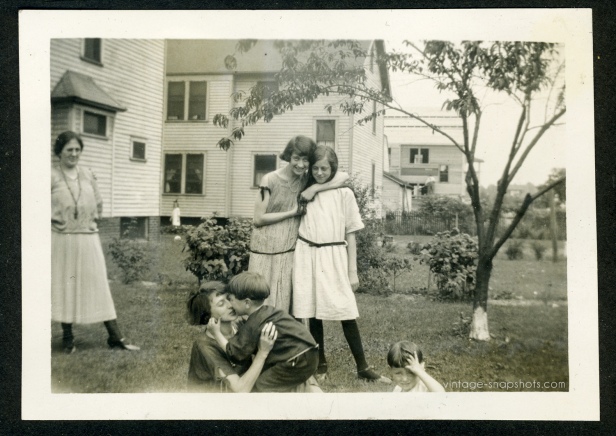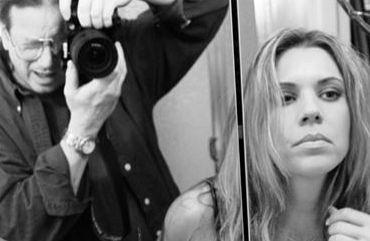Growing up in the digital age the concept of “snapshot” is pretty much obsolete. Millions of people are casually shooting trillions of photos on smart phones, tablets and other devices so that taking pictures of everything ands anything on a regular basis has become pretty much the “new normal.”
But a little more than a hundred years ago nothing like this was possible. Photography was a technologically complex process done by individuals with a lot of special training. If you wanted a portrait done or photos shot of your family you went to a professional. Those working with the dry plate or wet plate silver-halide process would make exposures, produce proofs and then the client would order prints. With another process like the
tintype you would sit for a photo and a finished product would be delivered to you in minutes. But none of the technology before the invention of roll film by George Eastman in the 1880s involved anything remotely like “do it yourself.”
[caption id="attachment_5790" align="alignnone" width="616"]

Credit: Unknown Photographer/Public Domain[/caption]
Roll film and the availability of professional photo processing created the popularity of the box camera, such as the Kodak Brownie, which suddenly allowed anyone who wanted to create photos to simply click a button, send in the film for processing and in a short time obtain a set of prints of anything they felt motivated to create images of.
The age of the snapshot had begun.
[caption id="attachment_5789" align="alignnone" width="570"]

Credit: Unknown Photographer[/caption]
[caption id="attachment_5785" align="alignnone" width="616"]
 Source: vintage-snpashots.com
Source: vintage-snpashots.com[/caption]
Talk about disruptive! Suddenly there was no need to go to a studio and hire a professional photographer to get pictures of your friends, family or anything else that interested you. “You Press The Button, We Do The Rest” was Kodak’s extremely effective advertising message. Instead of carefully constructed, technologically complex professional photos you suddenly had millions of “snap” shots. This not only made DIY photography possible, but also created informal records of daily life,that had never existed in the past. Snapshots represented documents of life as people lived it, how they looked, what they did, what their interests were. Of course, in the digital age this documenting of everyday life has become even more ubiquitous.
Thousands of snapshots became millions and now trillions. We are living in the best visually documented age in all of history. But this is something most pretty much take for granted. After 100 years plus of snapshots we already understand the concept. Digital has just accelerated the process.
[caption id="attachment_5798" align="alignnone" width="500"]

Credit: Public Domain[/caption]
And in terms of digital images disrupting the professional photography business, we also have an example from the past. Imagine you had a photo studio in 1900 and somebody came to you and says, “Guess what Kodak has just introduced?” It would have been easy to dismiss this as “not real photography,” and believe that amateurs with a box camera would not take business away from technologically competent pro photographers producing high quality images.
But, man, would you have been be wrong!
[caption id="attachment_5783" align="alignnone" width="616"]

Source: Retro Snapshots[/caption]
As I said, the disruption we see today has already happened once before. And who knows what kind of disruptions the future has in store for us? Innovation in terms of image making has certainly going to continue – perhaps going in directions we can hardly imagine today.
[caption id="" align="aligncenter" width="402"]

Credit: Kodak[/caption]
***********************************
Bill Dobbins is a pro photographer located in Los Angeles. He is a veteran photographer and videographer who has exhibited his fine art in two museums and a number of galleries and who has published eight books, including two fine art photo books:
WEBSITES
[caption id="attachment_5792" align="alignnone" width="600"]

Credit: Unknown Photographer[/caption]
[caption id="attachment_5799" align="alignnone" width="616"]

Source: vintage-snapshots.com[/caption]
 Credit: Unknown Photographer/Public Domain[/caption]
Roll film and the availability of professional photo processing created the popularity of the box camera, such as the Kodak Brownie, which suddenly allowed anyone who wanted to create photos to simply click a button, send in the film for processing and in a short time obtain a set of prints of anything they felt motivated to create images of.
The age of the snapshot had begun.
[caption id="attachment_5789" align="alignnone" width="570"]
Credit: Unknown Photographer/Public Domain[/caption]
Roll film and the availability of professional photo processing created the popularity of the box camera, such as the Kodak Brownie, which suddenly allowed anyone who wanted to create photos to simply click a button, send in the film for processing and in a short time obtain a set of prints of anything they felt motivated to create images of.
The age of the snapshot had begun.
[caption id="attachment_5789" align="alignnone" width="570"] Credit: Unknown Photographer[/caption]
[caption id="attachment_5785" align="alignnone" width="616"]
Credit: Unknown Photographer[/caption]
[caption id="attachment_5785" align="alignnone" width="616"] Source: vintage-snpashots.com[/caption]
Talk about disruptive! Suddenly there was no need to go to a studio and hire a professional photographer to get pictures of your friends, family or anything else that interested you. “You Press The Button, We Do The Rest” was Kodak’s extremely effective advertising message. Instead of carefully constructed, technologically complex professional photos you suddenly had millions of “snap” shots. This not only made DIY photography possible, but also created informal records of daily life,that had never existed in the past. Snapshots represented documents of life as people lived it, how they looked, what they did, what their interests were. Of course, in the digital age this documenting of everyday life has become even more ubiquitous.
Thousands of snapshots became millions and now trillions. We are living in the best visually documented age in all of history. But this is something most pretty much take for granted. After 100 years plus of snapshots we already understand the concept. Digital has just accelerated the process.
[caption id="attachment_5798" align="alignnone" width="500"]
Source: vintage-snpashots.com[/caption]
Talk about disruptive! Suddenly there was no need to go to a studio and hire a professional photographer to get pictures of your friends, family or anything else that interested you. “You Press The Button, We Do The Rest” was Kodak’s extremely effective advertising message. Instead of carefully constructed, technologically complex professional photos you suddenly had millions of “snap” shots. This not only made DIY photography possible, but also created informal records of daily life,that had never existed in the past. Snapshots represented documents of life as people lived it, how they looked, what they did, what their interests were. Of course, in the digital age this documenting of everyday life has become even more ubiquitous.
Thousands of snapshots became millions and now trillions. We are living in the best visually documented age in all of history. But this is something most pretty much take for granted. After 100 years plus of snapshots we already understand the concept. Digital has just accelerated the process.
[caption id="attachment_5798" align="alignnone" width="500"] Credit: Public Domain[/caption]
And in terms of digital images disrupting the professional photography business, we also have an example from the past. Imagine you had a photo studio in 1900 and somebody came to you and says, “Guess what Kodak has just introduced?” It would have been easy to dismiss this as “not real photography,” and believe that amateurs with a box camera would not take business away from technologically competent pro photographers producing high quality images.
But, man, would you have been be wrong!
[caption id="attachment_5783" align="alignnone" width="616"]
Credit: Public Domain[/caption]
And in terms of digital images disrupting the professional photography business, we also have an example from the past. Imagine you had a photo studio in 1900 and somebody came to you and says, “Guess what Kodak has just introduced?” It would have been easy to dismiss this as “not real photography,” and believe that amateurs with a box camera would not take business away from technologically competent pro photographers producing high quality images.
But, man, would you have been be wrong!
[caption id="attachment_5783" align="alignnone" width="616"] Source: Retro Snapshots[/caption]
As I said, the disruption we see today has already happened once before. And who knows what kind of disruptions the future has in store for us? Innovation in terms of image making has certainly going to continue – perhaps going in directions we can hardly imagine today.
***********************************
Bill Dobbins is a pro photographer located in Los Angeles. He is a veteran photographer and videographer who has exhibited his fine art in two museums and a number of galleries and who has published eight books, including two fine art photo books:
Source: Retro Snapshots[/caption]
As I said, the disruption we see today has already happened once before. And who knows what kind of disruptions the future has in store for us? Innovation in terms of image making has certainly going to continue – perhaps going in directions we can hardly imagine today.
***********************************
Bill Dobbins is a pro photographer located in Los Angeles. He is a veteran photographer and videographer who has exhibited his fine art in two museums and a number of galleries and who has published eight books, including two fine art photo books:
 Credit: Unknown Photographer[/caption]
[caption id="attachment_5799" align="alignnone" width="616"]
Credit: Unknown Photographer[/caption]
[caption id="attachment_5799" align="alignnone" width="616"] Source: vintage-snapshots.com[/caption]
Source: vintage-snapshots.com[/caption]







